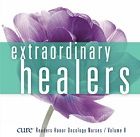Publication
Article
Extraordinary Healer®
The Extraordinary Everyday Healer
Author(s):
SOME CANCER TREATMENT CENTERS are mere conveyer belts for infusion.
SOME CANCER TREATMENT CENTERS are mere conveyer belts for infusion. Then there are those that transform the experience into a time of caring and spiritual healing. In a small satellite office of a large oncology practice, one nurse— the only nurse—makes that happen.
EARLY IN 2012, my husband Ted’s care was transferred to Ocala Oncology, now a part of Florida Cancer Affiliates, in Ocala, Florida. He has been dealing with prostate cancer for 14 years and started on a new state-of-the-art treatment. Our hopes were high that this medication would be the answer—not a cure, but at least a period of remission. Unexpectedly, in May of that year, I became a patient as well after being diagnosed with ovarian cancer.
During the initial visit, my heart fell. The satellite center is a cheerless, windowless place. We met Regina Ayers, the oncology nurse who directs treatment for all of the patients. Her manner assured us that the cheer and the light came from within the spirit of the four-person team and the bonds that formed among patients. While treatment held its difficulties, it turned out she was right about spirit and bonds.
Like most infusion centers, the action is nonstop. Seven reclining chairs serve a continuing stream of patients. Alarms punctuate the calm, many of them sounding at the same time. The challenge is managing situations that arise suddenly. Equipment malfunctions. Patients develop complications. Drugs must be given in sequence. Physicians require unique responses to their particular management styles. Some cancer patients are scared, some are angry, some of us just want to be rid of our burden of treatment and act out accordingly.
These issues are a fact of life which Gina describes as “trying to put together a puzzle. Nothing is more stressful than boredom and nothing more satisfying than being relevant and privileged enough to make a difference.”
For her, the puzzles are endless. She addresses malfunctions with persistence, competing alarms with unflappable patience. Patient complications are always the priority, yet they take their place in the queue of priorities, always in collaboration with respective physicians. One day, I witnessed a couple arguing, making no effort to hide their hostility from any of us. The patient was about to be hospitalized directly from the center. While Gina made every effort to support them during the transfer, she later conveyed her understanding about their anger, feeling that much of it was covering fear.
Gina developed compassion from two sources. The first was family. She is one of four natural and three adopted siblings. There were countless foster children in and out of the household. Gina and her husband have two children from the foster care system as well. Her mother worked as a nursing assistant throughout her career. In sharing anecdotes from work, her mother conveyed the importance of the relationship with patients, even those who were not conscious. She saw the effect of a comatose patient change completely when a nurse referred to her as having a “wasted life”—a lesson not lost on Gina.
The second source was her personal health experiences. At age 12, doctors suspected leukemia. This revelation was terrifying, but eventually proved to be incorrect. Numerous surgeries and the loss of a baby have strengthened her resolve to be helpful to other people during their time of need. After making her way up the career ladder from vocational nurse to registered nurse, she aspired to become an oncology nurse.
Throughout treatment, I personally felt that when my turn came for attention, I was the only patient in the room. From visit to visit, she remembered the books I was reading and shared information about the books on tape that she played for her kids en route to school and activities. We often shared travel and family information. While her mind constantly monitored the treatment plans for seven patients, her attention was fixed; the patient in front of her was the only focus.
As my chemotherapy treatments ended, Ted’s was just beginning. We joked that I had warmed a chair for him, but humor aside, we were devastated. For him, it’s a literal roulette game of treatment and the options are running out.
Gina is “there” for him at every turn, and in so doing, reminds me of a quote from another nurse’s memoir: “I learned that many times there was nothing to say, that sometimes just not turning away from people was the best way to care for them,” Beautiful Unbroken: One Nurse’s Life by Mary Jane Nealon
There are so many nurses quietly working day to day whose skills and quiet compassion provide either the spiritual healing or peaceful acceptance so necessary for a patient. Gina provides both for us. We continue our course of treatment and follow-up, along with a determination to live our days by squeezing the marrow out of each one, and never giving up. We are so much the richer for having her in our lives.






